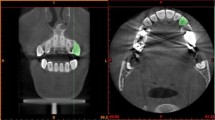Summary
In order to study mechanical stress on root from orthodontic tooth movement by sliding mechanics, a 3-dimensional finite element model incorporating all layers of a human mandibular dental arch with orthodontic appliance has been developed to simulate mechanical stress on root from the orthodontic tooth movement. Simulated orthodontic force of 2 N at 0, 30 and 45 degree from the horizontal axis was applied to the crown of the teeth. The finite element analysis showed when orthodontic forces were applied to the tooth, the stress was mainly concentrated at the neck of the tooth decreasing uniformly to the apex and crown. The highest stress on the root was 0.621 N/mm2 for cervical margin of the canine, and 0.114 N/mm2 for apical region of the canine. The top of canine crown showed the largest amount of displacement (2.417 μm), while the lowest amount of displacement was located at the apical region of canine (0.043 μm). In conclusion, this model might enable one to simulate orthodontic tooth movements clinically. Sliding force at 2 N is ideal to ensure the bodily orthodontic tooth movement. The highest stress concentration in the roots was always localized at the cervical margin when orthodontic force of 2 N at 0, 30 and 45 degree from the horizontal axis, so there may be the same risk of root resorption when orthodontic force of 2 N at 0, 30 and 45 degree was used in clinic cases.
Similar content being viewed by others
References
Iwasaki L R, Beatty M W, Randall C J et al. Clinical ligation forces and intraoral friction during sliding on a stainless archwire. Am J Orthod Dentofacial Orthop, 2003,123:408–415
Kojima Y, Fukui H. Numerical simulation of canine retraction by sliding mechanics. Am J Orthod Dentofacial Orthop, 2005,127:542–451
Puente M I, Galban L, Cobo J M. Initial stress differences between tipping and torque movements. A three-dimensional finite element analysis. Eur J Orthod, 1996,18:329–339
Bourauel C, Vollmer D, Jager A. Application of bone remodeling theories in the simulation of orthodontic tooth movements. J Orofac Orthop, 2000,61:266–279
Ziegler P, Ingervall B. A clinical study of maxillary canine retraction with a retraction spring and with sliding mechanics. Am J Orthod Dentofacial Orthop, 1989,95:99–106
Raboud D W, Faulkner M F, Lipsett A W. Three dimensional effects in retraction appliance design. Am J Orthod Dentofacial Orthop, 1997,112:378–392
Ren Y, Maltha J C, Kuijpers-Jagtman A M. Optimum force magnitude for orthodontic tooth movement: a systematic literature review. Angle Orthod, 2003,73:86–92
Chang Y I, Shin S J, Baek S H. Three-dimensional finite element analysis in distal movement of the maxillary dentition with the multiloop edgewise archwire. Eur J Orthod, 2004,26:339–345
Schneider J, Geiger M, Sander F G. Numerical experiments on long-time orthodontic tooth movement. Am J Orthod Dentofacial Orthop, 2002,121:257–265
Author information
Authors and Affiliations
Corresponding author
Rights and permissions
About this article
Cite this article
Li, P., Mao, J., Peng, Z. et al. Three-dimensional finite element analysis of the mechanical stress on root from orthodontic tooth movement by sliding mechanics. J. Huazhong Univ. Sci. Technol. [Med. Sci.] 27, 745–747 (2007). https://doi.org/10.1007/s11596-007-0634-8
Received:
Issue Date:
DOI: https://doi.org/10.1007/s11596-007-0634-8




